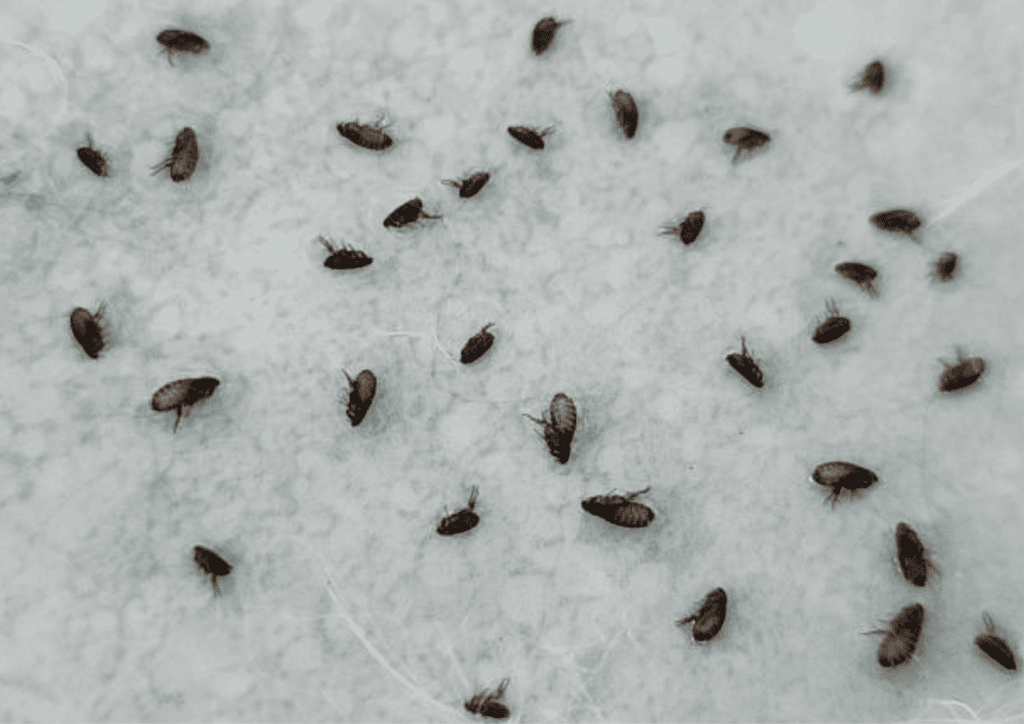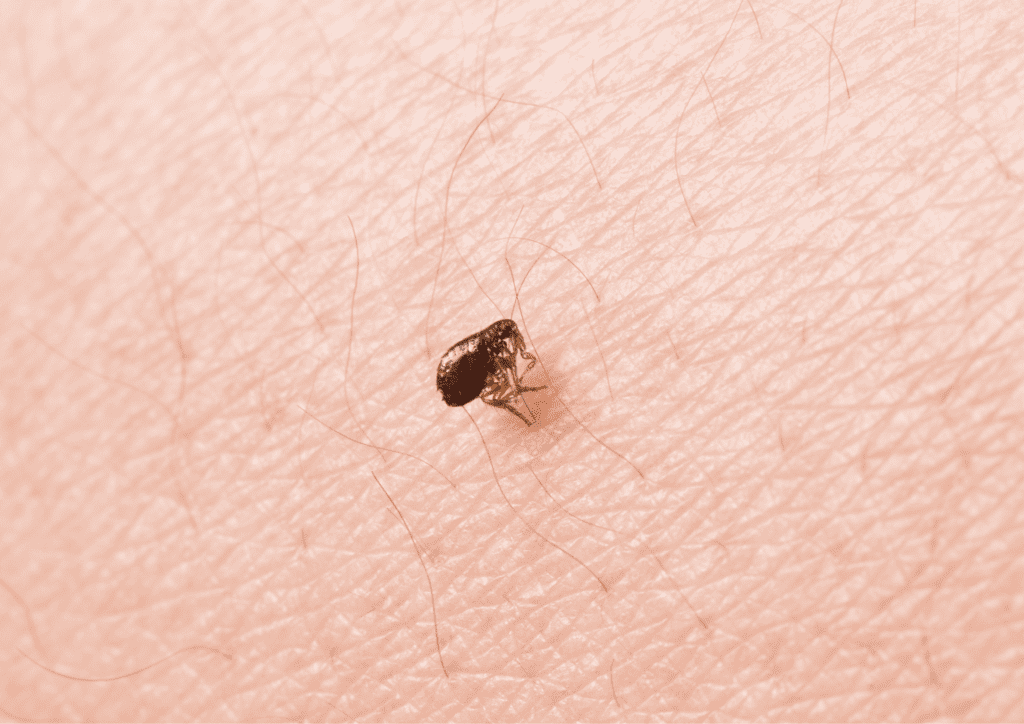Fleas are persistent and annoying pests that can infest not only your beloved pets but also your home. Finding a safe and effective solution for flea control is vital, and many people turn to natural remedies like tea tree oil.
In this article, we will explore the effectiveness, safety, and proper use of tea tree oil as a flea repellent and treatment for dogs, cats, and humans. We will also discuss the potential risks and side effects, guidelines for proper dilution, and practical applications of tea tree oil for flea control in various settings. So, let’s dive in and find out whether tea tree oil is the right choice for combating those pesky fleas!
POINTS
- Tea tree oil can be effective in repelling and killing fleas when used correctly and in proper dilutions; however, its effectiveness may vary, and results may be best when combined with other flea-control methods.
- Using undiluted or concentrated tea tree oil on pets can be risky, potentially leading to toxicity and other side effects. It’s crucial to follow proper dilution guidelines and consult a veterinarian before using tea tree oil on your pets.
- Diluted tea tree oil can be used as a flea repellent on humans but should be used cautiously, checking for possible skin irritation or allergic reactions before applying it more broadly.
- Tea tree oil can be utilized in various household settings as a flea repellent by making a homemade spray and applying it to targeted areas such as carpets, furniture, and baseboards.
- It’s essential to be aware of the potential risks and side effects of using tea tree oil for flea control, such as skin irritation and toxicity in pets, and monitor pets and humans closely for any adverse reactions.
The Use of Tea Tree Oil as a Flea Repellant
What is tea tree oil?

Tea tree oil is a natural essential oil derived from the leaves of the Melaleuca alternifolia tree, native to Australia. Known for its antiseptic, antifungal, and anti-inflammatory properties, tea tree oil has been used for various health and beauty applications, including treating acne, dandruff, and minor wounds. Recently, it has also gained popularity as a natural remedy for pest control, especially fleas.
Why is tea tree oil considered an “especially risky” treatment for fleas according to the Merck Veterinary Manual?
While tea tree oil has been used by many for some success in flea control, the Merck Veterinary Manual categorizes it as an “especially risky” treatment. This is mainly because of its potential toxicity to pets, particularly cats and small dogs, if ingested or when used in concentrated forms. Tea tree oil can cause skin irritations, tremors, excessive drooling, vomiting, and even difficulty breathing or walking in severe cases.
Effectiveness of Tea Tree Oil Against Fleas
Does tea tree oil kill fleas?
Tea tree oil, when used in undiluted concentrations, can indeed kill fleas. Its natural components, including terpenoids, are toxic to these pests. However, using undiluted tea tree oil directly on your pets or household surfaces is not recommended due to the potential health risks and side effects it can cause.

Can tea tree oil repel fleas?
Yes, tea tree oil can repel fleas when used properly and used with other flea-control methods. The oil’s odor is known to repel fleas and other insects, making it a useful natural pest deterrent. Keep in mind that while tea tree oil may repel fleas, it may not be as effective as synthetic chemical treatments.
How is tea tree oil used as a flea repellent?

Tea tree oil can be used as a flea repellent by:
- Diluting it with water or carrier oil and applying it to affected areas or surfaces.
- Make a flea-repellent spray by mixing tea tree oil with water and spraying it on your pet’s bedding, carpets, and furniture.
Remember, it is crucial to dilute the oil properly to avoid potential side effects.
How does tea tree oil compare to other oils in repelling or killing fleas?
To better understand the role of tea tree oil in flea control, it’s useful to compare its effectiveness with other popular essential oils used against fleas. Below is a table outlining how tea tree oil stands up against various methods in both killing and repelling fleas.
| Essential Oil | Kills Fleas | Repels Fleas | Notes |
|---|---|---|---|
| Tea Tree Oil | Yes | Yes | Effectiveness varies; best when used in dilution. |
| Lavender Oil | No | Yes | Safe for pets; mild repellent effects. |
| Eucalyptus Oil | Yes | Yes | Natural and safe; requires frequent application. |
| Lemon Oil | No | Yes | Non-toxic; repels fleas with citrus scent. |
| Cedarwood Oil | Yes | Yes | Effective and safe for use around pets. |
Please be advised that while these oils may help deter fleas, their effectiveness may vary depending on several factors, such as concentration and the specific pests being targeted. It is important to research and test different oils to determine the best-suited one for your situation.
Using Tea Tree Oil on Dogs and Cats for Flea Treatment
How effective is tea tree oil for treating dog fleas?
Tea tree oil can be effective in treating dog fleas when used correctly and with caution. However, its effectiveness depends on several factors, such as the severity of the infestation and whether it’s combined with other flea-control methods. As with any treatment, it’s essential to monitor your pet closely for any adverse reactions.
Is tea tree oil safe for use on dogs? What are the considerations when using tea tree oil for fleas on dogs?

Using tea tree oil on dogs can be safe when diluted appropriately and applied topically. However, it is crucial to avoid exposing your dog to concentrated tea tree oil. When using tea tree oil for fleas on dogs, consider the following precautions:
- Only use a properly diluted solution, ideally no more than 0.1% to 1% concentration.
- Perform a patch test to make sure your dog does not experience any adverse reactions.
- Avoid applying the oil to sensitive areas, such as the eyes, ears, and nose.
- Observe your dog closely after applying the treatment and consult your veterinarian if you notice any signs of discomfort or irritation.
How effective is tea tree oil for treating cat fleas?

Tea tree oil can help in treating cat fleas, although its effectiveness may not be as strong as other treatment options. Like with dogs, the success of tea tree oil for cat fleas depends on several factors, including proper dilution and combination with other flea-control methods.
Is tea tree oil safe for use on cats? What are the considerations when using tea tree oil for fleas on cats?
Cats are generally more sensitive to essential oils than dogs, and using tea tree oil on cats can be risky. Ingestion or exposure to high concentrations of tea tree oil can lead to toxicosis in cats. If you decide to use tea tree oil for fleas on cats, it is crucial to take the following precautions:
- Talk to your veterinarian before using tea tree oil on your cat for proper guidance and recommendations.
- Use a very low concentration, ideally below 0.1%, to minimize the risks.
- Perform a patch test on your cat to check for any adverse reactions.
- Monitor your cat closely after treatment and seek medical attention if there are any signs of discomfort, irritation, or worsening symptoms.
Utilizing Tea Tree Oil in Various Household Settings for Flea Control
How to use tea tree oil for fleas in carpet, furniture, and house?

To use tea tree oil for fleas in carpets, furniture, and around the house, you can make a homemade flea spray. Mix a few drops of tea tree oil with water in a spray bottle and lightly mist the affected areas. Focus on spots where fleas are most likely to hide, such as pet bedding, upholstery, and baseboards.
Does tea tree oil get rid of fleas in these various settings?
Tea tree oil can help repel and, to some extent, eliminate fleas in household settings. However, using tea tree oil alone may not be enough to completely get rid of an infestation. Combining tea tree oil with other natural treatments, such as diatomaceous earth or regular vacuuming, may yield better results.
Safety and Precautions When Using Tea Tree Oil on Humans
Does tea tree oil kill or repel fleas on humans?

Tea tree oil can be effective in repelling fleas on humans due to its strong odor. It may also help kill fleas when applied directly, but this is generally not advised as it may cause skin irritation or other side effects.
How safe is tea tree oil for use on humans in the context of flea control?
Tea tree oil is generally safe for use on human skin when properly diluted, typically at a concentration of around 2% to 5%. It is essential to perform a patch test on a small area of the skin to ensure no adverse reactions occur before applying it more broadly.
How to properly use tea tree oil for fleas on humans?
To safely use tea tree oil for fleas on humans, follow these guidelines:
- Create a diluted solution by mixing a few drops of tea tree oil with a carrier oil, such as coconut or almond oil. Make sure the concentration is within the safe range of 2% to 5%.
- Perform a patch test on a small area of the skin to ensure no irritation or allergic reaction occurs.
- Gently apply the diluted tea tree oil solution to the affected areas, avoiding the eyes, nose, and mouth.
- Monitor the skin for any signs of irritation or discomfort and discontinue use if needed.
Exploring Other Uses of Tea Tree Oil in Pest Control
Can tea tree oil kill or repel ticks?

Tea tree oil has been found to have some effectiveness in repelling ticks, although its efficacy in killing ticks is less clear. To use tea tree oil as a tick repellent, dilute the oil and apply it to the skin or clothing before going outdoors in tick-infested areas.
How to use tea tree oil to remove ticks on dogs?

When using tea tree oil to remove ticks on dogs, follow these steps:
- Dilute tea tree oil in a carrier oil, such as coconut or almond oil. Remember to maintain a safe concentration, typically between 0.1% and 1%.
- Apply the diluted solution to a cotton swab or cotton ball.
- Gently dab the cotton swab on the tick, taking care not to squeeze the tick, as this may cause it to release more saliva, increasing the risk of infection.
- After a few minutes, the tick should release its grip, allowing you to remove it with tweezers.
- Clean the area with soap and water, then apply diluted tea tree oil to the bite site to minimize the risk of infection.
Is tea tree oil effective against other parasites, such as ear mites in cats or skin parasites?
There is limited evidence to support the effectiveness of tea tree oil against other parasites, such as ear mites in cats or skin parasites. While some anecdotal evidence exists, more research is needed to confirm its efficacy and safety when used for these purposes. Always consult a veterinarian before attempting to use tea tree oil to treat ear mites or skin parasites in pets.
Understanding Fleas: Their Behavior and Preferences
What do fleas hate or not like?
Fleas are repelled by strong odors and certain natural ingredients, such as essential oils like tea tree, lavender, eucalyptus, and lemon. They also prefer to avoid sunlight and dry environments. Frequent vacuuming, washing pet bedding, and maintaining a clean environment can help deter fleas.
What essential oils do fleas hate, and how does tea tree oil compare?
Some of the essential oils that fleas hate include tea tree, lavender, eucalyptus, lemon, and cedarwood. Tea tree oil compares well to these other options, with its strong odor acting as an effective flea repellent. However, its effectiveness can vary, and results may be best when combined with other flea-control methods.
What natural remedies exist for flea treatment in puppies under 12 weeks?

For puppies under 12 weeks, it is best to avoid using essential oils, including tea tree oil, as these can cause adverse reactions. Instead, use natural remedies such as a mild soap and water bath, a fine-toothed flea comb, and diatomaceous earth spread on the puppy’s bedding to control fleas.
Practical Application: How to Use and Dilute Tea Tree Oil for Flea Control
Proper dilution of tea tree oil is crucial for safe and effective use, especially when it comes to flea control on pets and in household applications. Below is a table that provides clear guidelines for diluting tea tree oil for different uses, ensuring safety for pets, humans, and during household applications.
| Use Case | Dilution Ratio | Carrier Oil/Water | Additional Notes |
|---|---|---|---|
| Dogs | 0.1% to 1% concentration | Carrier oil (e.g., coconut, almond) | Always perform a patch test before full application |
| Cats | Below 0.1% concentration | Carrier oil (e.g., coconut, almond) | Use with extreme caution; consult a vet first |
| Humans | 2% to 5% concentration | Carrier oil or water | Perform a skin patch test to check for allergies |
| Household Cleaning | 1% concentration | Water | Use in a spray bottle for easy application |
| Flea Repellent Spray | 0.5% concentration for pets, 1-2% for humans | Water | Adjust based on the area of application |
These guidelines help ensure that tea tree oil is used in a way that maximizes its benefits while minimizing potential risks. Always start with the lowest possible concentration, especially when using tea tree oil on pets or sensitive skin, to observe how it’s tolerated before proceeding with stronger solutions.
How to dilute tea tree oil for fleas?
To dilute tea tree oil for flea control, mix it with a carrier oil like coconut or almond oil. Aim for a concentration of 0.1% to 1% for dogs and under 0.1% for cats. For humans, use a concentration between 2% and 5%.
How much tea tree oil should be added to dog shampoo for flea treatment?

For a 12-ounce bottle of dog shampoo, add approximately 6 to 12 drops of tea tree oil for a safe concentration. Always check with your veterinarian before adding tea tree oil to a pet’s shampoo to ensure proper dosage and safety.
What is a good tea tree oil flea spray recipe or a tea tree oil dog spray recipe?

A simple tea tree oil flea spray recipe is as follows:
- Fill a 16-ounce spray bottle with water.
- Add 20 to 30 drops of tea tree oil (or adjust the amount based on recommended concentrations for your specific application).
- Shake the mixture well before use, and spray on targeted areas, taking care to avoid pets’ eyes, nose, and mouth.
Possible Risks and Side Effects of Using Tea Tree Oil for Fleas
What if a dog accidentally licks tea tree oil?

If a dog licks undiluted tea tree oil or a highly concentrated solution, it can cause poisoning due to the toxic compounds. Symptoms of tea tree oil poisoning in dogs include vomiting, drooling, weakness, tremors, and difficulty walking. If you suspect your dog has ingested tea tree oil, contact your veterinarian or an emergency animal clinic immediately.
What are potential risks and side effects of using tea tree oil for fleas?
Using tea tree oil for fleas can present some risks and side effects, particularly when used improperly or in high concentrations. These risks include:
| Side Effect | Affected Species | Symptoms | First Aid Response |
|---|---|---|---|
| Skin Irritation | Humans, Pets | Redness, itching, swelling | Wash the area with soap and water; apply a soothing lotion. |
| Toxicity (if ingested) | Pets | Vomiting, lethargy, tremors, difficulty walking | Contact a veterinarian immediately; do not induce vomiting unless instructed. |
| Allergic Reactions | Humans | Hives, rash, difficulty breathing | Discontinue use; for severe reactions, seek medical attention. |
| Eye Irritation | Humans, Pets | Redness, watering, pain | Rinse the eye with clean water for at least 15 minutes; if irritation persists, seek medical advice. |
| Ear Toxicity | Pets (Cats > Dogs) | Disorientation, excessive drooling, vomiting | Immediate veterinary consultation is crucial. |
To minimize these risks, always dilute tea tree oil appropriately, follow recommended guidelines, and consult your veterinarian for advice.
Conclusion: The Role of Tea Tree Oil in Flea Control
Tea tree oil can play a role in flea control and repellent when used properly and combined with other flea-control methods. However, it is crucial to follow proper dilution guidelines, observe pets closely for adverse reactions, and consult a veterinarian to ensure safe and effective use. By maintaining a clean and hygienic environment and regularly monitoring pets for signs of fleas, tea tree oil can be a valuable addition to your flea control toolkit.



